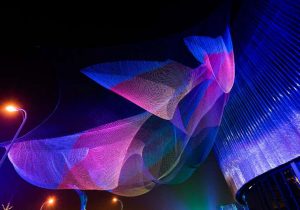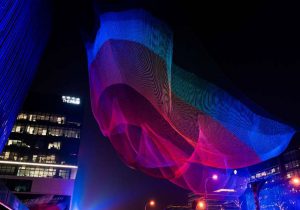For this week’s Looking Outwards entry, I wanted to explore the work of Janet Echelman, who explores expression in art through “experimental sculpture at the scale of buildings.” Echelman’s work began its roots during her time at the fishing village Mahabalipuram, where she was waiting for some of her paints to arrive for an exhibition. Inspired by the sculpting culture in the village and the fishermen’s nets, Echelman now installs netted sculptures at the scale of buildings, that seek to express/capture both light and wind.

The image above exhibits one of Echelman’s projects in Shanghai,China. The sculpture is titles “1.26” and seeks to explore the idea of “interconnectedness of opposites.” The work exhibits the tension between what is hard and soft, what can be changed and what cannot be touched.

(The total sculpture spans 80ft long x60ft wide x30ft in depth)
The data used to create such structure uses NASA and NOAA data from the 2010 Chilean earthquake and tsunami. The reason the piece is titled “1.26” is because the earthquake’s shake actually sped the earth’s rotation, shortening the time of the day by 1.26 micro-seconds.
As seen in the video below, the way the data was implemented into the form of the sculpture stems from the points of tension and trends in the data. These correlations in data were then transcribed into programmed lights and the interweaving of polyethylene (UHMWPE) fiber.
What I particularly like about this work is how it expressed such complicated data in a clear, visual form that also ties in the emotional aspect/ reaction to such an event that is lost in numbers.
More information at:
![[OLD FALL 2018] 15-104 • Introduction to Computing for Creative Practice](wp-content/uploads/2020/08/stop-banner.png)